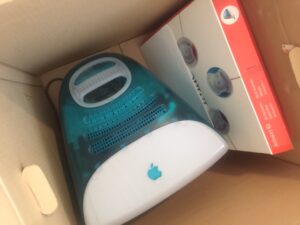 When ED acquired a gift for grandpa in 1999 the world no longer thought of computers as boring beige plastic boxes. Apple introduced the very first iMac in 1998 in Bondi Blue. BONDI?? Yes, named for the surfer’s favorite beach, and that gave a new meaning to the verb to surf. Grandpa never used this gift. Now she’s inherited it BACK, and needs to know the history and the value.
When ED acquired a gift for grandpa in 1999 the world no longer thought of computers as boring beige plastic boxes. Apple introduced the very first iMac in 1998 in Bondi Blue. BONDI?? Yes, named for the surfer’s favorite beach, and that gave a new meaning to the verb to surf. Grandpa never used this gift. Now she’s inherited it BACK, and needs to know the history and the value.
Some of us will remember the Apple ads from 1999. The shot looked down on the tops of five wedge shaped colored iMacs, all five colors of the new line. Bondi became a moderate success in 1998. So in January 1999 Apple CEO Steve Jobs announced the launch of five colors, a range of fruit colors. The ads said “collect them all:” blueberry, grape, tangerine, lime, and strawberry. Sounds almost corny and sappy. Other Apple ads called the colors “iCandy” that contained no artificial colors.
ED ordered a blueberry iMac shipped to grandpa.
He didn’t trust it with his personal information, and hid it in his garage, never opening the box. ED’s grandpa’s computer originally shipped in a HUGE red box. Yes, computers in 1999 were fat, and looked a bit like the head of a space fantasy robot.
The iMac, the iMac DV (Digital Video), and the iMac DV Special Edition, all wedge shaped with a clear to frosted colored enclosure, came in this “family of colors.” The special edition appeared slightly different and more expensive in that its enclosure was translucent and glossy, as opposed to the hazier plastic of the standard fruit flavored Macs.
The colors became a success, so in the summer of 2000, Apple introduced five more colors with less corny associations: indigo, sage, ruby, graphite, and snow, another series of FIVE. When I think of the color minimalist of today, Jobs seems ahead of the game. He retired the strident ruby and sage pretty quickly and replacing them with two other Special Editions in colors, the Flower Power enclosure, and the Blue Dalmatian enclosure. The later is to die for with blue and teal spots on white clear plastic.
Out with the Beige
Hard to believe that in 1997 Apple sold JUST 1.8 million Macs. So, when they introduced colors in 1998-9, the new iMac G3 helped Apple make a profit for the first time in three years. It enabled Jobs to come back to Apple, and it stopped me from using floppy disks. Macs became the top sellers in US stores for three months, and changed the way designers thought about computer components. Like I said, it broke the mold. Beige plastic framed screens in a beige plastic box were OUT.
When I look into the value of these for ED, some collectors exist who love the glow these things display when turned on. I found one buyer who owns all thirteen colors of 1999-2000, and still buyers duplicates. So, buyers do exist for this LOOK, but of course the market likes a usable computer, and sad to say, the size and power of these pales in comparison to today’s gear. But they’re COOL….
Collectors Do Exist
I did find a seller with the whole set-up who asked $1,000. Most folks with unused iMac G3’s in the original box are happy for them to leave their garages for $300 and up. However, I noticed the tech collectors are a RICH group of youngsters, and in my opinion that to hang onto this technology might be wise. In 2014, Bonhams put a rare Apple-1 computer up for auction in New York. Estimated to go for between $300,000 and $500,000, it ended up selling for a whopping $905,000. Years later, that’s NOT the highest known price anyone ever paid for a vintage Apple computer, but it shows how what was trash 25 years ago, will surprise you in value TODAY. A working Apple-1, one of the tech giant’s first line of computers introduced back in 1976, came up for auction on eBay for $1.5 million USD in 2021. If you have the desk space, use it!